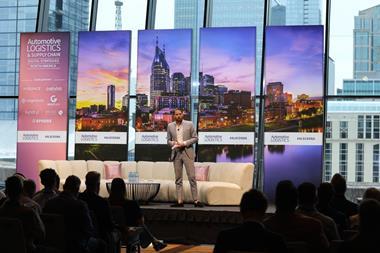When it comes to innovations in logistics, the automotive industry is good at confirming the merits of its own success, but it might do better to look beyond its own factories towards solutions from other industries, as there are signs it is losing ground in logistics developments as it continues to nurse well-documented inefficiencies.
At May’s ELUPEG group meeting—the European Logistics Users, Providers and Enablers Group, an association dedictated to promoting logistics collaboration—hosted at DHL’s state-of-the-art Innovation Centre near Bonn, Germany, speakers recognised that the automotive industry has traditionally led innovations for supply chain efficiency and that it continues to hold itself up as a best practice benchmark. Prof. Dr Sebastian Kummer, from the WU Vienna University of Economics and Business, recognised how the sector has collaborated with its transport providers well in meeting the needs of what are arguably the strictest inbound supply demands in terms of delivery windows, inventory and supply chain complexity.
However, according to other members, the automotive sector might be taking too much of its own publicity to heart, in that it is missing out on opportunities for collaborative innovation. Speakers worried that the automotive industry’s own efficiency could be making it inflexible.
According to delegates, there are some areas in automotive logistics that are crying out for improvement. Empty and circuitous return legs on inbound shipments, low-capacity utilisation in finished vehicle movements and an intractable attitude to overcoming antitrust issues were just some areas highlighted. Contributors heard that early progress made at ELUPEG on the subject of shared aftermarket deliveries stalled because contributors refused to countenance the movement of competitor parts within their own brand-liveried vehicles.
Other sectors, including fast moving consumer goods (FCMG) and hi-tech, appear now to be taking the lead, with more examples of shared-user services and collaboration. DHL’s Ingo Brauckmann and Paul Eden Smith outlined how its Tradeteam joint venture with Molson Coors for the drinks industry improved transport costs through a highlevel of synergy and was a prime example of the shift from a traditional supply chain with various inventory points to a collaborative consumer end-toend supply chain with one single inventory point.
By contrast the automotive sector was seen as simply confirming its current paradigm, rather than looking at new innovations through exposure to cross-industry solutions.
This was in part because of an unwillingness to share or cede control to potential partners and suppliers. The whole effort at collaborative enterprise depends on a shared level of efficiency, noted Brian Bolam, deputy chairman of ELUPEG, and president and founder of OmPrompt, a B2B integration provider. “The more efficient you are yourself, the easier it is to collaborate,” he said. “You have to do everything you can in-house first to get lean, and when you run out of leverage, you have to go outside and get some more help to drive your costs down to the next level.”
Bolam used the example of Ford as a carmaker that had “a slick supply chain”. But while Ford’s LLP strategy might make it more open to collaboration, others appear less keen to collaborate, perhaps out of fear that a partner would fail to come up to standard.
But an insular attitude was also contributing to fractious relationships between carmakers and transport providers within the sector, said Bolam.
“One of the ways to take the heat out of the situation is to look at the supply chain as a means to an end rather than a competitive weapon,” he said.
There had been some success that came from discussions held at ELUPEG in the past, such as the development of shared inbound milkruns between major OEMs. Discussions around the CO³ project, designed to encourage structural breakthrough in the competitiveness and sustainability of European logistics by stimulating collaboration between European shippers, suggested that the initiative had born fruit.
However, the carmakers who had participated (and remain members of ELUPEG) had failed to return to share the details of their success, said Bolam, and they were conspicuous by their absence at May’s meeting.
It was a gap that the organisation said it was keen to rectify by its next meeting in Amsterdam in November.
Container shipping spot rates on the Asia-Europe trade soared in the early part of the year, rising nearly fourfold from December to early May before starting to fall again. According to Drewry analyst Martin Dixon, carriers focused on rate recovery in an attempt to restore profitability. To support these initiatives,carriers withdrew capacity on the trade by around 11% quarteron- quarter through the course of the first quarter through service suspensions and vessel lay ups. The combination enabled them to force spot rates up to profitable levels. By early May, the World Container Index assessed by Drewry for the trade from Shanghai to Rotterdam had risen above the high recorded in March 2010, when rates last peaked. However, spot rates have fallen 17% because of poor demand growth, economic volatility and the launch of new services. Air freight has also declined, and Drewry expects both air and container rates to soften further.





































